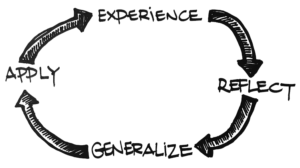Experiential learning (EXL) is an approach when the learners acquiring knowledge through experience. It is a student-centered approach which requires learners devote their interest into the learning. During the learning process, instructor is not the only leader who stands on the center or in the front of the classroom. Instead, each of the student could be the “teacher” of the class. Compared to traditional learning process, EXL structured in a more flexible way. It requires learners actively engage in the learning process, and reflect what they have learned through experience. With their understanding of the knowledge, learners are able to illustrate it to others in their own way. The process of sharing their own understanding to other learners could be considered as a reinforcer of learning. Kolb’s learning cycle is a common example of experiential learning approach.
In the group project, we will focus on teaching English to ESL (English as Second Language) learners. Among four parts of English learning — listening, speaking, reading and writing, experiential learning approach could be applied for the first two parts. Although most English teaching are emphasizing more on reading and writing, the other two are the essential skills need to be learned. To let students engage in the English Café is a good activity of experiential learning. Many of the ESL learners have problems with the pronunciation of those english words, English café provides them an occasion to practice speaking and listening. By having conversations with others, speaking skill and listening skill are enhanced. On the other hand, students could learn better on how to use different english words under different situations. However, experiential learning approach is only helpful for english speaking and listening. It is better to find out another approach that could be applied for the other two parts (reading & writing).




